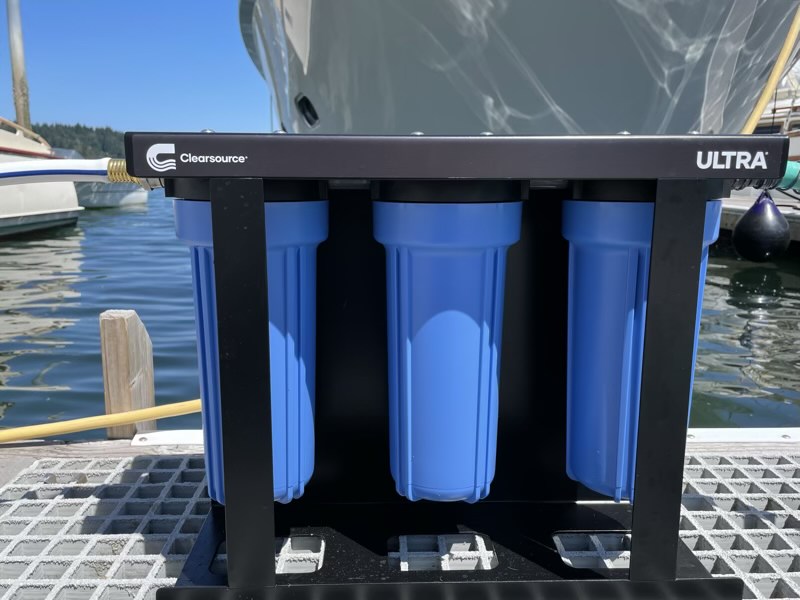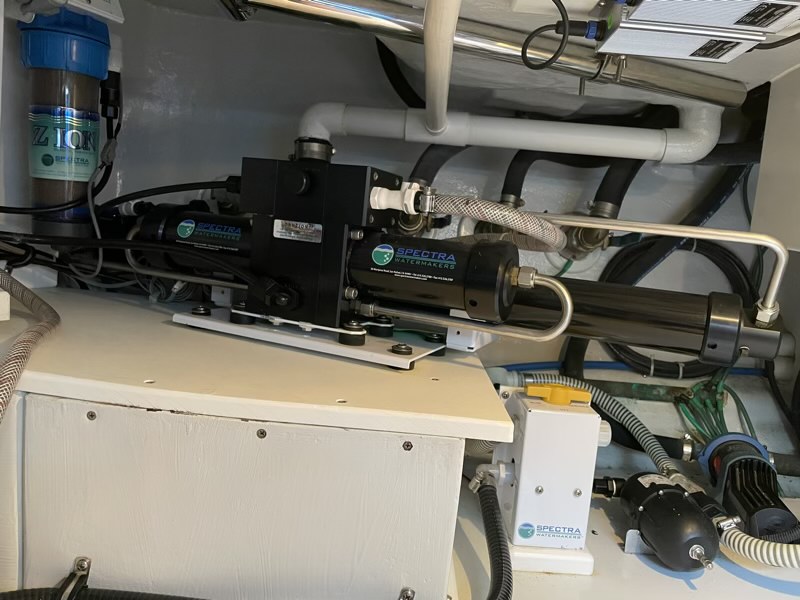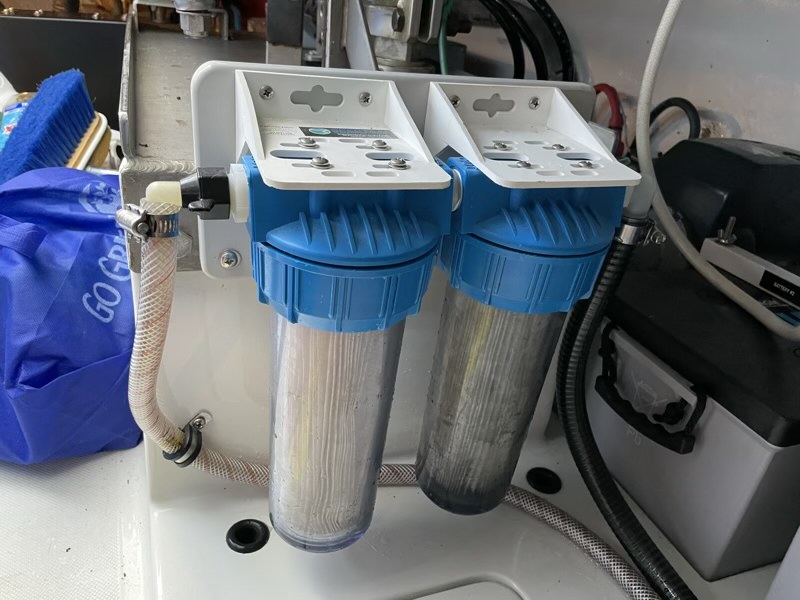On a boat, the most basic conveniences of life — like running water — require forethought and attention. In this post, we explore how we manage water aboard our Nordhavn 43 trawler.
Ample fresh water aboard Indiscretion is one of the many extravagances we enjoy aboard this expedition trawler. Our Catalina sailboat had just 50 gallons of fresh water, which we stretched to six or seven days of cruising with careful dishwashing and quick cockpit showers for the kids. The trawler holds 300 gallons of fresh water with onboard water-making capability that, in theory, provides us with an infinite supply.
With greater supply comes greater use. Besides washing dishes, we take hot showers every day and wash our clothes in a Splendide combination washer/dryer. Every toilet flush uses fresh water. I wash down the boat using fresh water outlets in the bow and stern after most passages. Even the watermaker uses fresh water during its flushing routine. Between two people, we use about 50 gallons of water a day when we’re cruising. With our 300 gallon tank, that equates to six days of water — ironically, the same as our sailboat.
But Can We Drink It?
Water treatment on our sailboat was pretty simple. Once a year, I treated the 50-gallon tank with a small amount of bleach and let it sit overnight. I drained and refilled the tank twice, then patted myself on the back for a job well done.
On the trawler, it’s not so simple. For one thing, draining and filling a 300-gallon water tank takes a long time, let alone twice. And wasting that much fresh water makes me cringe. But more importantly, bleach damages the expensive membrane in watermakers that use fresh water for periodic flushing and is, therefore, a no-no in our trawler’s water system.
Without our bleach routine, I had concerns about the potability of water from the tanks without some kind of water treatment or filtering process. I considered installing an inline water treatment system, but in the end, we opted for the simplicity of a dockside water filter setup that many RV owners use. We bought an Ultra with VirusGuard from ClearSource that filters incoming dock water in three stages: a 5-micron filter that removes any sediment or rust in the water; a 0.5-micron coconut shell carbon filter for improved taste and smell; and finally, a NASA-designed filter that removes any bacteria, cysts, and viruses from the water before it enters our tank. We keep a Brita water filter pitcher in the galley for drinking water.

We keep the Ultra in the lazarette locker and pull it out when we take on water at docks. The filters last about a year and a replacement set costs about $60 from ClearSource. While dock water here in the Pacific Northwest is generally potable, we definitely noticed an improved taste in our water after switching over to this filter system.
Water, Water Every Where
Besides a large water tank, we have a Spectra watermaker that transforms seawater into drinking water using a desalination process. The system makes 12.5 gallons of fresh water an hour, so we can keep up with our daily usage by running the system four hours a day. For expeditions like our planned trip up the inside passage to Alaska, we’ll run the watermaker in open water while underway and never worry about running short.

Making water at anchor is also possible, but comes with some cautions. Our system utilizes two pre-filters — a 20-micron filter and a 5-micron filter — before seawater enters the watermaker itself. When making water in open sea, these pre-filters might need to be cleaned every two or three months. When making water at anchor, the pre-filters might need to be cleaned daily or even hourly. The Spectra provides a pre-filter status on a control panel in the pilothouse during the water-making process that helps you track how mucked up the pre-filters have become.
The process of cleaning (or replacing) pre-filters is straightforward, if a bit disgusting: First, the seacock that feeds seawater to the watermaker must be turned off to prevent flooding the lazarette. Then, you unscrew the filter bowls from their housings with a filter wrench, careful not to spill too much seawater. I learned to keep a disposable aluminum baking pan nearby to catch the inevitable spills. Once the filters have been extracted, they get rinsed using a seawater wash-down hose on the swim platform. Words fail to describe the smell coming off these filters during this hosing-off process: a bouquet of rotten eggs, seaweed, decay, and a dark, primordial stench you hope washes off as it splashes around your bare feet. When the filters look clean and the water runs clear, they get a final rinse of fresh water and spend a couple of days of drying in the sun to kill off any lingering sea life before being put back in rotation for the next filter swap. A pre-filter can withstand a half dozen cleanings like this before needing to be discarded. I pop in a clean pair of filters from a supply I keep near the watermaker and apply a little silicone grease to the o-ring of the filter housing to keep a good seal before reattaching. Finally, I reopen the watermaker seacock, and we’re back in the watermaking business.

We had family join us midway through a long stretch of anchoring during a recent cruise through the San Juan Islands. I had neglected to run the watermaker, and our water tank was getting low. We were anchored inside Garrison Bay on the northwest corner of San Juan Island, which was crowded with boats ahead of the July 4th holiday. I decided to make water in the morning and night to coincide with our daily running of the generator to boost our water supply. However, after just one hour, the pre-filter alarm sounded in the pilothouse. The brand new pre-filters I installed at the start of our cruise were miserably clogged. I cleaned the filters and tried again, only to have the alarm sound again the next hour. Either the bay was too shallow (we had just five feet under our keel at low tide) or too crowded, but I gave up trying to make water after the second alarm. We had to watch our water usage for a couple of days — no showers, careful dishwashing, etc. Leaving Garrison Bay, I ran the watermaker on our two-hour trip to Sucia Island without any trouble and again once we were anchored in Echo Bay to replenish our tank.
I learned I need to be more proactive about managing our water levels when we’re away from docks. I had many opportunities to make water ahead of our stay in Garrison Bay, but became complacent. Likewise, I discovered that some anchorages are much better for making water than others, that making water is better on an incoming tide, and that the best water you can make is underway in open sea.
Did We Just Run Out of Water?
Indiscretion has Tecma electric toilets that magically flush with fresh water at the touch of a button. I still delight in this technological marvel after so many years of pumping seawater by hand into the heads of our sailboats.
About halfway through our recent cruise, I encountered a problem with our master stateroom toilet. Pressing the flush button caused the toilet to make all the sounds of a proper flush, but no water flowed through the bowl. Huh.
I tried the nearby sink. No water. I tried the galley sink. Nothing. I knew the tank couldn’t be empty. If a tap had been left open, we would have heard the water pump cycling. Could the tank itself have developed a leak? My mind raced through all the dependencies we had on running water. Toilet flushing rose quickly to the top. No water, no toilets. I began cursing myself for not keeping a spare pump aboard. A Marco UP6/e supplies our water and runs about $700 to replace. I was waiting to buy one on sale, but hadn’t found a deal before leaving for this trip. Ugh.
I powered off the water pump at the distribution panel and waited a few adrenaline-filled moments before powering it back on. Resetting power to the water pump restored water pressure. Whew! A scan of the Marco operating manual led me to a series of coded blinking lights on the pump itself, which could mean overheating, an obstruction, or a leak somewhere in the system. A quick search on the Nordhavn Owner’s Group forum revealed that other owners with this pump had similar malfunctions without a clear resolution apart from powering off and on.1
That morning, I ordered a spare Marco pump from Fisheries Supply in Seattle by express delivery to Roche Harbor Marina. I may be $800 poorer, but I’ve eliminated a critical dependency aboard this expedition trawler that would disrupt our cruising plans. A captain must keep the water flowing and the toilets flushing!
Questions or comments about water systems aboard Indiscretion? Leave us a comment below.
- Once back in port, I checked the water filter that feeds into the Marco pump. After cleaning out a fair amount of debris, the pump has functioned flawlessly. ↩
